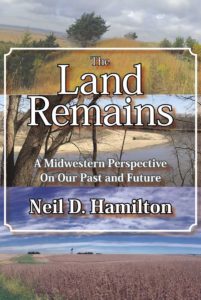Review of Neil Hamilton’s “The Land Remains”
 Many of us baby boomer farm kids recall growing up in the 1950s and 60s walkin’ beans, baling hay and having quail in the fencerows, along with “the back 40.” But you don’t need a time machine to recapture that era – and to ponder the future of Iowa agriculture. Just read “The Land Remains: A Midwestern Perspective on Our Past and Future” by Neil D. Hamilton.
Many of us baby boomer farm kids recall growing up in the 1950s and 60s walkin’ beans, baling hay and having quail in the fencerows, along with “the back 40.” But you don’t need a time machine to recapture that era – and to ponder the future of Iowa agriculture. Just read “The Land Remains: A Midwestern Perspective on Our Past and Future” by Neil D. Hamilton.
Raised on an Adams County, Iowa, farm, Neil earned forestry and law degrees before becoming director of the Agricultural Law Center at Drake University in Des Moines. He recently retired after 36 years. His memoir traces his growing awareness of how our agricultural policies have shaped not only the land, but also the very fabric of our society.
At its essence, Neil writes, farming is “all about joy” – harnessing “sun, rain and seeds to create new wealth” or working with livestock “to bring forth new generations of animals.” But he’s troubled by Iowa’s not-so-joyful transition from 200,000 small, diverse family farms to one-third that many industrial-scale operations. He offers a sobering analogy between Appalachia and Iowa.
Appalachian farmers lost their autonomy to economic, social and environmental degradation brought on by the extractive coal and timber industries. Iowa’s extractive industries are corn and pigs. “We are essentially mining our soil and water resources,” he says, “extracting fertility and future productivity to raise crops used for industrial purposes or export.”
Can we learn from history? Neil celebrates the conservation contributions of Iowans John F. Lacey, Aldo Leopold, Henry A. Wallace and J. N. “Ding” Darling. He admires Leopold’s “land ethic,” which argues that humans have a moral duty to care for the land, including all of nature – and he returns often to that theme. He suggests that public policies in the 1930s and 40s acknowledged the importance of soil conservation; but that by the end of the 1950s, the vision and leadership of FDR’s era were “largely abandoned, replaced by the economic determinism still haunting farm country today.”
To be sure, farm organizations and the Iowa Legislature came to agree on the voluntary Iowa Nutrient Reduction Strategy – which supposedly will reduce nutrients leaving farm fields and flowing to the Gulf of Mexico. Unfortunately, Neil says, the strategy “can best be summarized as high hopes and best wishes, or less charitably, faith in magical thinking.”
Yet he takes heart in the “rustling whispers of doubt” he’s hearing from people concerned “about the food we eat and what it means for the land.” To help tell the story, he enlists the occasional voice of “The Back 40,” a perceptive plot of land hidden in the center of his home farm. Noting, for example, how some landowners are struggling to re-create prairie after their ancestors broke the virgin sod 150 years ago, The Back 40 wryly observes that “my time frame is so different than yours.”
We need leaders with the vision to make changes, Neil says, citing World Food Prize recipient D. Rattan Lal of Ohio State University, who proposed a federal Healthy Soils Act akin to the Clean Air Act and Clean Water Act. He also praises groups like PFI and the Iowa Natural Heritage Foundation. When Neil needed to sell part of his family’s land, he made sure it went to a young farmer committed to keeping it healthy, rather than to an absentee investor.
“It may be hard in stressful times to think about the land as a priority,” Neil writes. “The truth is, now is an excellent time to focus on Land because it is enduring and it provides a source of hope.” The Back 40, also hopeful, expects a “spark of imagination” from scholars like the boy who went away to law school.
“My hope is you will find the genius in the law and the imagination in your hearts to protect me,” The Back 40 says, “and to make it possible the land remains.”
Larry A. Stone has authored five books and spent 25 years as the outdoor writer and photographer for the Des Moines Register. He and his wife, Margaret, manage her family’s small crop farm in Tama County, Iowa, along with the woodlands, prairie and wildlife and their own farm near Elkader, Iowa. Learn more at larrystonesiowa.com.
